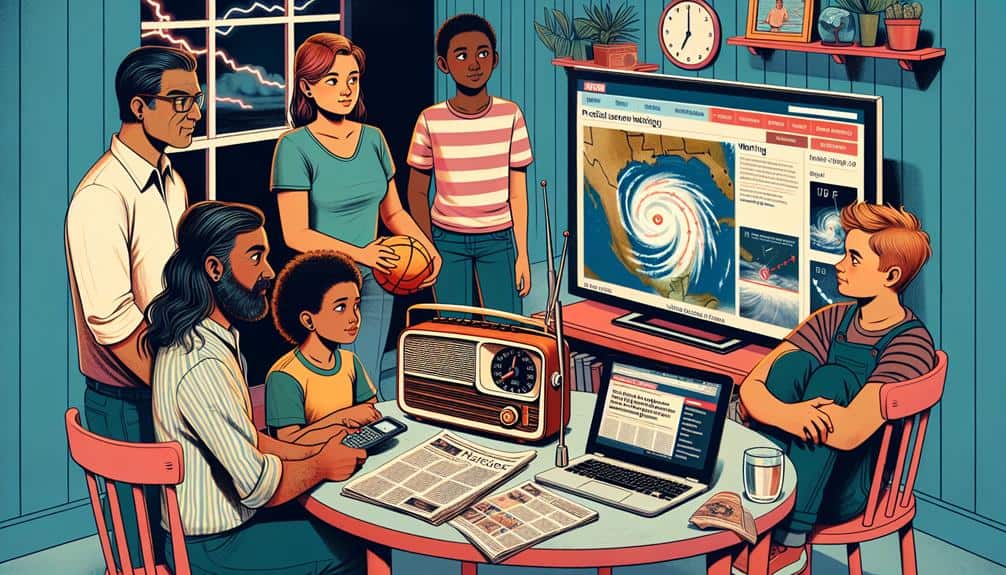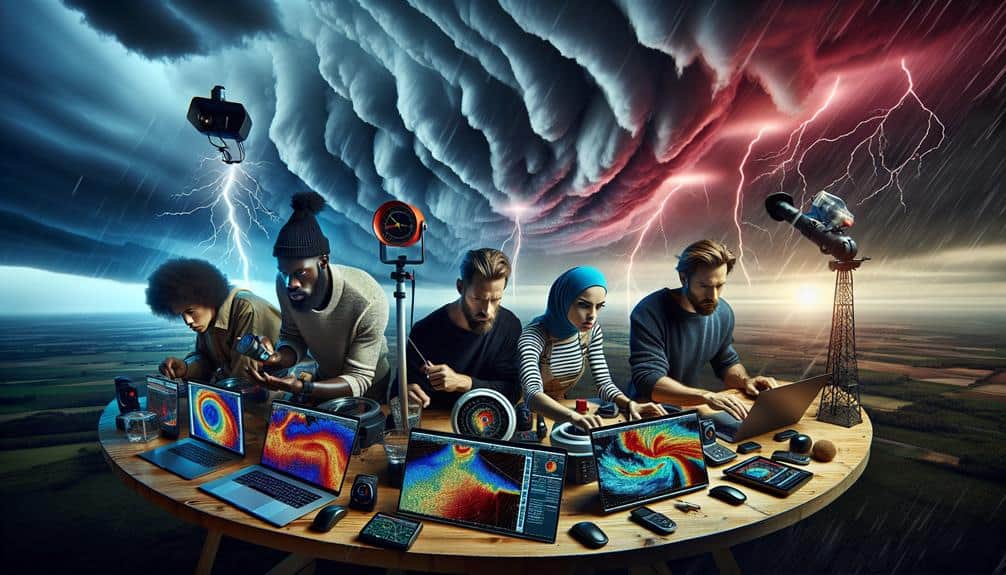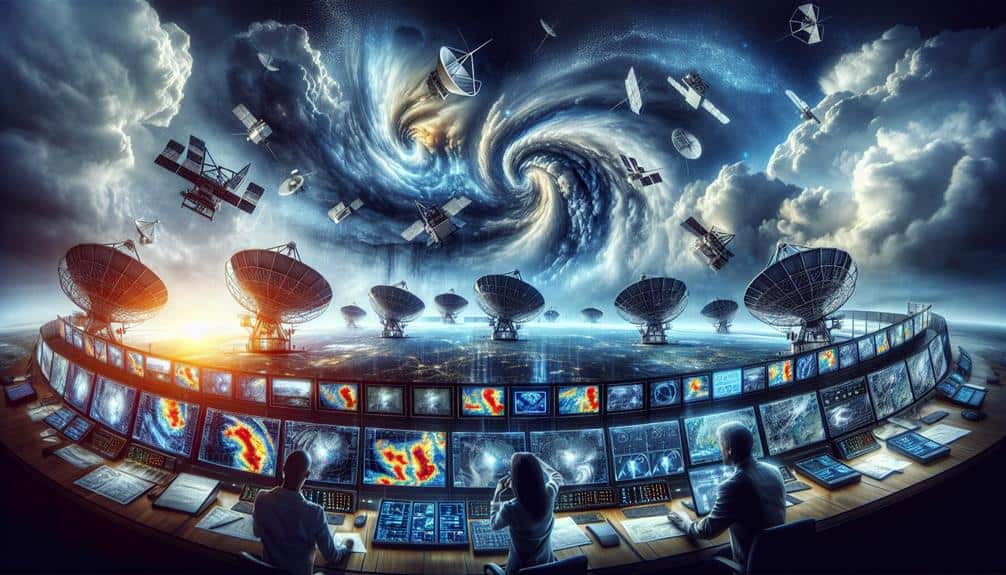For accurately tracking hurricane paths, we should use satellite imagery to monitor cloud formations, wind speeds, and atmospheric pressure in real time. Regular meteorological updates and mobile apps like NOAA Weather Radar Live offer up-to-date tracking tools. Analyzing historical hurricane data with machine learning improves predictive models. Local news provides essential information on evacuation plans and community impacts. Social media can also be important for receiving real-time alerts from sources like the National Hurricane Center. By leveraging these scientific resources, we'll have a thorough understanding of hurricane trajectories and potential impacts. There's more to discover about each tool's capabilities.
Key Points
- Utilize mobile apps like NOAA Weather Radar Live for real-time hurricane path updates and interactive storm maps.
- Monitor satellite imagery for precise data on cloud formations, wind speeds, and atmospheric pressure.
- Follow official social media accounts such as the National Hurricane Center for immediate and reliable updates.
- Regularly check local news for evacuation plans, community impact reports, and real-time weather updates.
Use Satellite Imagery
Leveraging satellite imagery, we can accurately monitor and predict the paths of hurricanes by analyzing real-time data on cloud formations, wind speeds, and atmospheric pressure. The precision of satellite technology allows us to track these weather patterns with remarkable data accuracy. By examining high-resolution images and telemetry, we identify changes in storm intensity and direction early, giving us a pivotal edge in storm prediction.
Our ability to process and interpret this vast amount of satellite data hinges on the advancements in remote sensing instruments. These tools measure parameters like sea surface temperatures and barometric pressure, which are vital for understanding a hurricane's development and trajectory. The data we gather from satellites helps us construct predictive models that forecast potential landfall areas and impact zones.
In essence, the integration of satellite technology in meteorology empowers us to make informed decisions. By staying ahead of the storm, we can better prepare and protect communities, ensuring greater freedom from the unpredictability of natural disasters.
The consistent, real-time monitoring provided by satellites is invaluable for enhancing the accuracy and reliability of our storm prediction efforts.
Follow Meteorological Updates
To complement the insights gained from satellite imagery, we must consistently follow meteorological updates to refine our hurricane tracking models and predictions. Meteorological predictions provide real-time data on atmospheric pressure, wind speed, and temperature variations, which are essential for accurate storm tracking. By integrating these updates with satellite data, we enhance our ability to predict a hurricane's path and intensity with greater precision.
We should rely on authoritative sources like the National Hurricane Center (NHC) and the Joint Typhoon Warning Center (JTWC) for the latest forecasts and advisories. Their models incorporate vast datasets and advanced algorithms to generate predictive analytics. Regularly updating ourselves with their reports ensures that our storm tracking remains aligned with the latest developments.
Furthermore, meteorological updates enable us to adjust our tracking models dynamically. For instance, if a sudden change in sea surface temperature is detected, we can swiftly recalibrate our predictions to account for potential shifts in the hurricane's trajectory. By staying informed and adaptable, we empower ourselves to make more accurate, data-driven decisions, ultimately enhancing our safety and freedom in the face of natural disasters.
Leverage Mobile Apps
We can enhance our hurricane tracking by using mobile apps that provide real-time weather updates and interactive storm maps. These tools enable us to access precise meteorological data instantly, ensuring we stay informed.
Real-Time Weather Updates
Utilizing mobile apps for real-time weather updates allows us to access precise hurricane path data instantly. This immediacy is vital for our emergency preparedness. Mobile apps like NOAA Weather Radar Live and Hurricane Tracker provide up-to-the-minute information on storm trajectories, wind speeds, and rainfall. By leveraging these tools, we enhance our weather tracking capabilities, enabling us to make informed decisions swiftly.
Real-time updates are essential for those of us living in hurricane-prone areas. Data from these apps typically include satellite imagery, radar data, and predictive models, ensuring we've a detailed understanding of impending threats. This allows us to prepare evacuation plans, secure our homes, and gather necessary supplies well ahead of time.
For example, Hurricane Tracker provides National Hurricane Center updates, offering reliable forecasts and alert notifications. These features enable us to track the storm's evolution, from tropical depression to full-blown hurricane, with high accuracy. Furthermore, apps like Storm Shield offer severe weather alerts tailored to our location, ensuring we receive critical updates without delay.
In essence, mobile apps empower us with the data we need to protect our families and properties, making them essential tools in our hurricane preparedness arsenal.
Interactive Storm Maps
Interactive storm maps on mobile apps provide us with dynamic visualizations of hurricane paths, allowing us to analyze storm trajectories and predict potential impacts with greater accuracy. Leveraging these tools enhances our storm tracking capabilities, combining real-time data with user-friendly interfaces.
Interactive maps facilitate deeper user engagement by offering customizable layers, such as wind speeds, precipitation levels, and pressure systems.
Data visualization on these platforms is pivotal. We can pinpoint exact locations of a hurricane's eye, track its movement, and observe changes in intensity over time. These maps often incorporate satellite imagery and radar data, providing a detailed view of the storm. By integrating historical storm data, the apps can also forecast potential paths, giving us the freedom to make informed decisions swiftly.
Mobile apps like MyRadar, NOAA Weather Radar, and Storm Shield stand out due to their robust interactive features. These applications not only offer real-time updates but also allow us to set alerts for specific regions, ensuring we stay informed about critical changes.
Ultimately, interactive storm maps empower us to take control of our safety, making data-driven decisions that align with our need for freedom and preparedness.
Analyze Historical Data
Analyzing historical data on hurricane paths provides pivotal insights into patterns and trends that can enhance predictive models and improve preparedness.
By employing advanced data visualization techniques, we can transform complex datasets into comprehensible visual representations. These visual tools allow us to observe recurring paths, frequency, and intensity of past hurricanes, offering a foundation for more accurate predictions.
We leverage statistical modeling to identify significant variables influencing hurricane behavior. By examining factors like sea surface temperature, atmospheric pressure, and wind speed, we can construct models that anticipate future hurricane paths with greater precision. Predictive analytics plays a pivotal role in this process, as it uses historical data to forecast future events.
Incorporating machine learning algorithms further refines our predictive capabilities. These algorithms analyze vast amounts of historical data, identifying subtle patterns that might elude traditional statistical methods. By continuously learning from new data, these models become increasingly accurate over time.
Ultimately, our goal is to empower individuals and communities with the knowledge they need to make informed decisions. By understanding historical trends and employing cutting-edge analytical techniques, we can better anticipate hurricane behavior, thereby enhancing our overall preparedness and resilience.
Monitor Local News

We should monitor local news for real-time, reliable weather updates, which are essential for accurate hurricane tracking. These updates often include evacuation plans that can guide our immediate actions.
Additionally, local news provides community impact reports, offering insights into the hurricane's effects on infrastructure and residents.
Reliable Weather Updates
Staying tuned to local news broadcasts guarantees we receive the most accurate and timely updates on hurricane paths and potential impacts. Local stations provide real-time data and visualizations from weather radar systems, which are essential for tracking a hurricane's trajectory and intensity. By monitoring these updates, we can make informed decisions about our safety and preparedness.
Local news channels often collaborate with meteorological experts to deliver precise forecasts. These forecasts include important information about wind speeds, rainfall amounts, and storm surges, which can have a significant impact on our areas. With this data, we can better understand the potential risks and take appropriate actions.
To make sure we remain updated, here are four key practices:
- Subscribe to local news alerts: This ensures we're notified instantly of any changes in the hurricane's path or intensity.
- Follow social media updates from trusted sources: Many local news stations provide timely updates via social media platforms.
- Regularly check weather radar images: These images help us visualize the storm's current position and projected path.
- Identify nearby emergency shelters: Knowing the locations of these shelters beforehand can be crucial if evacuation becomes necessary.
Evacuation Plans Announcements
Monitoring local news closely allows us to stay informed about evacuation plans, ensuring timely and safe departure if necessary. By tuning into trusted local news sources, we receive real-time updates on critical information such as shelter locations and routes. These details are essential for making informed decisions about our safety.
Data-driven tracking of evacuation orders enables us to identify the best times for departure, minimizing risks and avoiding congested routes. Local news outlets provide precise information on shelter locations, including availability and capacity, which helps us choose suitable shelters that can adequately accommodate our needs.
Emergency supplies are another vital component of evacuation plans. News broadcasts often include lists of essential items, ensuring we're prepared with everything from non-perishable food and water to first aid kits and medications. This accurate information allows us to gather necessary emergency supplies efficiently, maximizing our preparedness.
Community Impact Reports
Local news broadcasts provide crucial community impact reports, delivering real-time data on affected areas, infrastructure damage, and ongoing relief efforts. By monitoring these reports, we can stay informed about the immediate and long-term impacts of hurricanes on our communities. Accurate information enhances our disaster response strategies and allows us to make informed decisions about safety and resource allocation.
Key aspects covered by local news include:
- Disaster Response Updates: Continuous coverage of local and regional response efforts, including the deployment of emergency services and coordination with federal agencies.
- Emergency Shelters: Information on the availability and location of emergency shelters, ensuring that those displaced have access to safe havens.
- Infrastructure Damage Assessments: Detailed reports on the extent of damage to roads, bridges, and utilities, which are critical for planning recovery and rebuilding efforts.
- Relief Efforts: Updates on ongoing relief operations, including the distribution of essential supplies such as food, water, and medical aid.
Utilize Social Media Alerts
In recent years, leveraging social media alerts has become an essential tool for real-time tracking and dissemination of hurricane path information. Platforms like Twitter, Facebook, and Instagram facilitate rapid emergency response and effective crisis communication. By following official accounts such as the National Hurricane Center (NHC) and local emergency management agencies, we can receive immediate updates on hurricane trajectories, wind speeds, and evacuation orders.
The data-driven nature of social media allows for precise, geotagged information, which enhances situational awareness. During Hurricane Harvey, for example, emergency responders utilized social media to locate individuals needing rescue. This real-time feedback loop improved operational efficiency and saved lives.
Similarly, crisis communication strategies employed by these platforms enable us to share verified information quickly, reducing the spread of rumors and misinformation.
Moreover, social media algorithms prioritize urgent updates, ensuring that pivotal alerts appear at the top of our feeds. This functionality is essential when minutes can mean the difference between safety and peril. By setting up notifications for key accounts, we can stay informed without constantly checking our devices.
In this way, social media becomes a powerful ally in safeguarding our communities during hurricane events.
Frequently Asked Questions
How Do Hurricanes Form in the First Place?
We observe hurricanes forming when tropical cyclones develop over warm ocean waters. Weather patterns, including low-pressure systems and atmospheric instability, create conditions for these powerful storms. Understanding these processes helps us predict and prepare for their impact.
What Are the Different Categories of Hurricanes?
Hurricanes fall into five categories based on their strength. We categorize them by wind speed: Category 1 starts at 74 mph, while Category 5 exceeds 157 mph. Each higher category represents greater destructive potential and urgency.
How Can I Prepare an Emergency Kit for a Hurricane?
Preparing an emergency kit is a lifesaver. We should include essential emergency supplies like food, water, and first aid. Knowing our evacuation routes is critical. Let's be ready; our freedom depends on our preparation.
What Should I Do if I Am Caught Outside During a Hurricane?
If we're caught outside during a hurricane, we must immediately seek emergency shelters. Knowing local evacuation routes is essential for quick, safe escape. Precise, timely decisions maximize our safety and preserve our freedom during such emergencies.
How Can I Protect My Home From Hurricane Damage?
To enhance home protection from hurricanes, we should install storm shutters, reinforce doors, and secure roofs. Data indicates these measures reduce structural damage to a considerable extent, offering us greater freedom to safeguard our homes and loved ones effectively.

